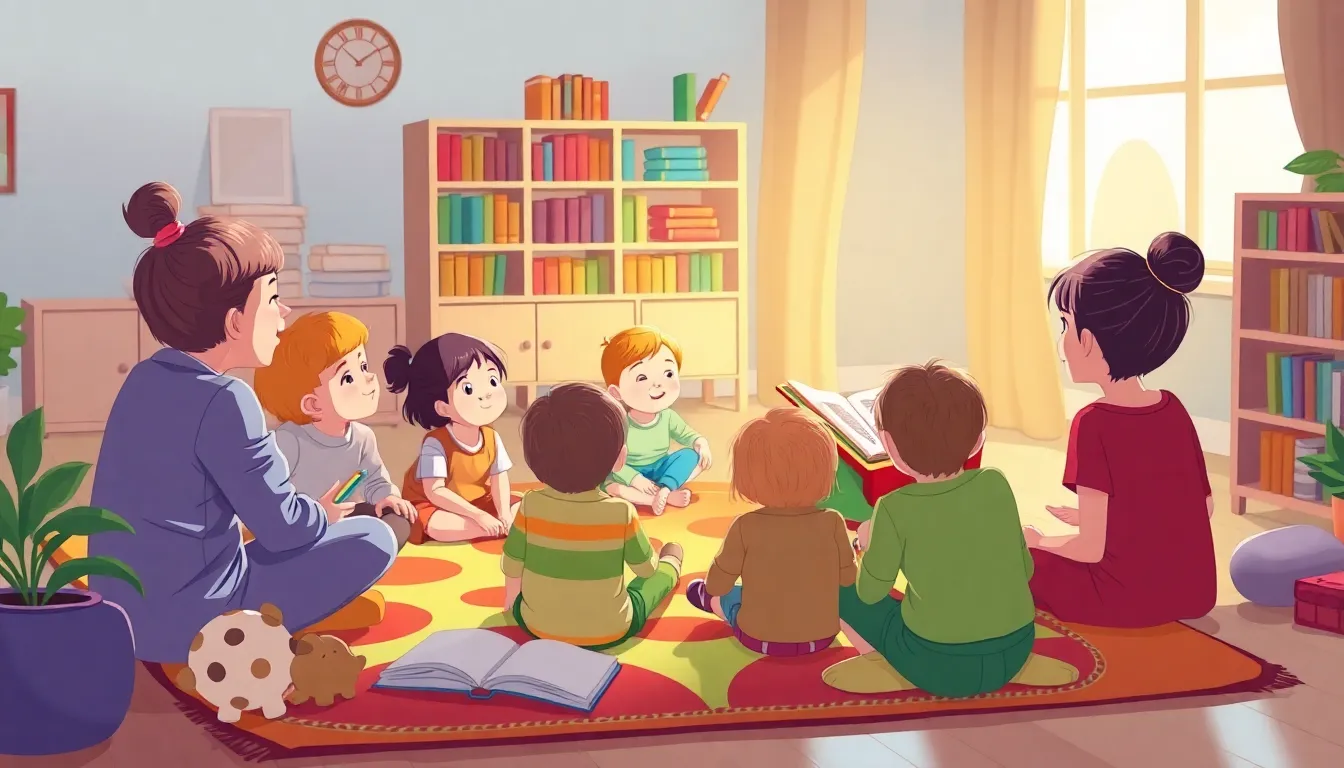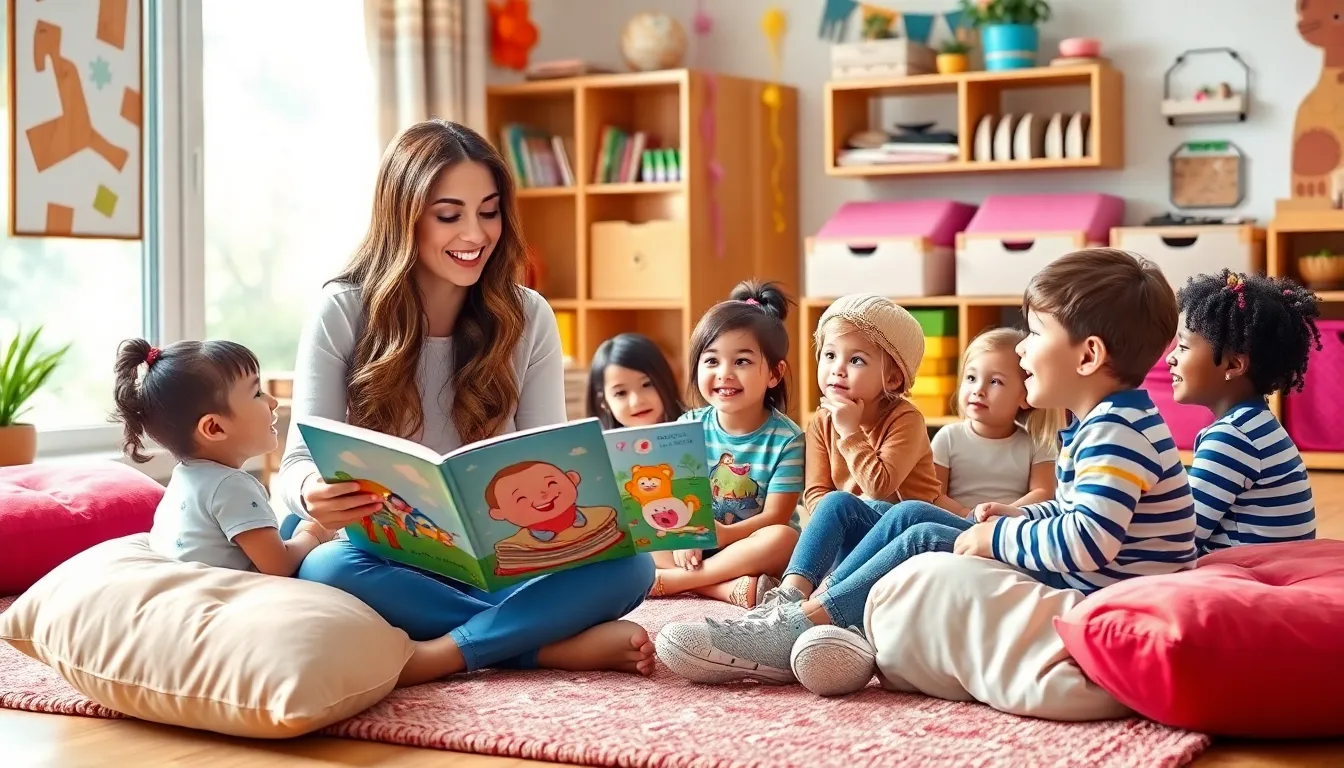Gather ’round, folks! It’s time to dive into the magical world of Storytime, where imagination runs wild and every tale is a ticket to adventure. Whether it’s a cozy evening with a classic fairytale or a thrilling journey through a fantasy realm, Storytime has a way of capturing hearts and sparking creativity.
Table of Contents
ToggleWhat Is Storytime?
Storytime captivates audiences of all ages through engaging narratives. This tradition fosters imagination and enhances creativity.
Definition and Purpose
Storytime refers to a dedicated time for reading stories aloud. It often occurs in classrooms, libraries, or homes, bringing people together. The primary purpose of Storytime involves sharing stories to entertain and educate listeners. Various genres, including fairy tales, fables, and contemporary literature, stimulate curiosity and foster a love for reading. Through this practice, children gain exposure to language, enhancing their vocabulary and comprehension skills.
Importance in Early Literacy
Early literacy thrives on interactive experiences. Storytime plays a vital role in children’s linguistic development and cognitive skills. Engaging narratives encourage critical thinking and active participation among young audiences. Listening to different stories introduces children to diverse cultures and ideas, broadening their perspectives. Furthermore, regular Storytime creates positive associations with reading, motivating children to explore books independently.
Benefits of Storytime

Storytime offers numerous advantages for children. Engaging with narratives promotes a range of developmental benefits that contribute to overall growth.
Cognitive Development
Cognitive development thrives during Storytime. Listening to stories helps children enhance their memory and comprehension skills. They develop critical thinking abilities as they predict plot outcomes and analyze characters’ motives. Exposure to varied storylines fosters creativity and imagination. Interactive elements, like asking questions, stimulate curiosity and boost cognitive engagement. Practical implementation can lead to improvements in problem-solving skills too.
Language Skills Enhancement
Language skills see significant enhancement through Storytime. Children encounter new vocabulary in context, which aids with retention and understanding. Listening to fluent reading models proper pronunciation and intonation, fostering better speech patterns. Storytelling also introduces narrative structure, expanding children’s ability to communicate ideas coherently. Regular participation helps build a strong foundation for writing skills, leading to greater literacy proficiency over time. Interactive reading sessions encourage discussions, further enhancing verbal skills.
Social and Emotional Growth
Social and emotional growth flourishes through shared Storytime experiences. Children connect with characters, empathizing with their emotions and situations, which builds empathy. Group Storytime fosters social interaction, teaching sharing and cooperation. Discussions about stories encourage open dialogue, strengthening communication skills and reinforcing emotional intelligence. Additionally, children learn valuable lessons about morals and values through narratives, shaping their understanding of relationships and societal norms. Engaging in Storytime creates a safe space for exploring feelings and navigating complex emotions.
Types of Storytime
Different types of Storytime cater to diverse audiences and objectives, each enhancing the storytelling experience. They include traditional storytelling, interactive Storytime, and digital Storytime.
Traditional Storytelling
Traditional storytelling focuses on sharing tales orally. It relies on a storyteller’s charisma to bring characters and settings to life. In this format, listeners engage with stories that may come from cultural folklore or classic literature. Storytellers often use vocal variation and body language to capture attention. Families and educators commonly use this approach to foster connections and spark imagination. These sessions promote an appreciation for narratives, ensuring that timeless stories remain alive for future generations.
Interactive Storytime
Interactive Storytime invites listeners to participate actively. Participants may engage in asking questions or reenacting parts of the story, boosting overall interaction. This format often incorporates props, sounds, or movements that add dimensions to the storytelling experience. Children discover enthusiasm for narratives when they are part of the action. Additionally, this type of Storytime encourages collaborative learning and social skills, as children share their thoughts and experiences related to the tale.
Digital Storytime
Digital Storytime utilizes technology to present stories through various platforms. E-books, podcasts, and animated videos represent some popular formats in this category. Children can access these stories from home or on-the-go, making literature more accessible than ever. Digital storytelling often features vibrant visuals and engaging sound effects, which captivate young audiences. While this approach offers convenience, it also encourages families to explore new narratives together, blending technology with traditional Storytime experiences.
Tips for an Engaging Storytime Experience
Creating a dynamic Storytime experience enhances engagement and fosters a love for reading. Consider these key strategies:
Creating a Comfortable Environment
Comfort is key in a Storytime setting. Arrange seating in a cozy, inviting manner to help listeners relax. Soft lighting creates a warm atmosphere, while quiet spaces minimize distractions. Incorporating blankets or cushions also adds a sense of security, making it easier for children to focus on the narrative.
Choosing the Right Books
Selecting age-appropriate, diverse books enriches the Storytime experience. Opt for titles that align with children’s interests to spark engagement. Classic tales allure with nostalgia, while contemporary stories resonate with modern themes. Varying genres broadens perspective, ensuring that listeners encounter a range of narratives. Include picture books that have vibrant illustrations, as they capture attention and complement the storytelling.
Incorporating Movement and Activities
Movement and activities turn Storytime into an interactive event. Encourage children to act out scenes from the story, allowing them to embody characters. Use props or puppets to enhance storytelling, engaging multiple senses. Incorporating songs or rhymes also boosts participation, creating a lively atmosphere. These techniques deepen comprehension and promote retention of the story, transforming a passive experience into an active exploration of literature.
Storytime is more than just reading aloud; it’s a powerful tool that nurtures children’s growth and development. By immersing young listeners in captivating narratives, it sparks their imagination and cultivates a lifelong passion for reading. The diverse formats of Storytime cater to various interests, making literature accessible and enjoyable for everyone.
Creating an engaging Storytime experience involves thoughtful preparation and a focus on interaction. With the right environment and activities, children can connect deeply with stories, enhancing their cognitive abilities and emotional intelligence. Ultimately, Storytime fosters a love for literature that can shape their future learning and creativity.



